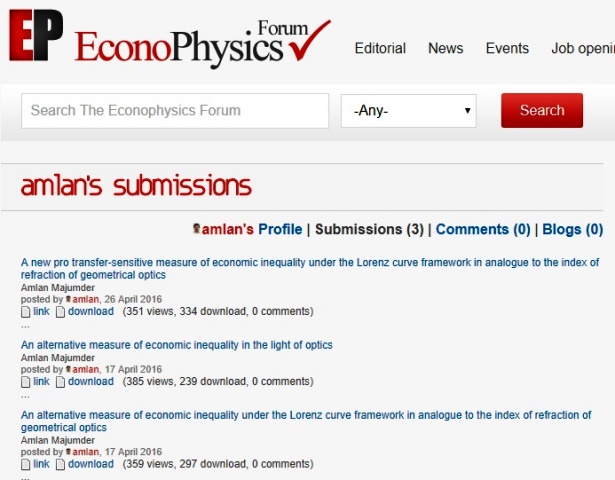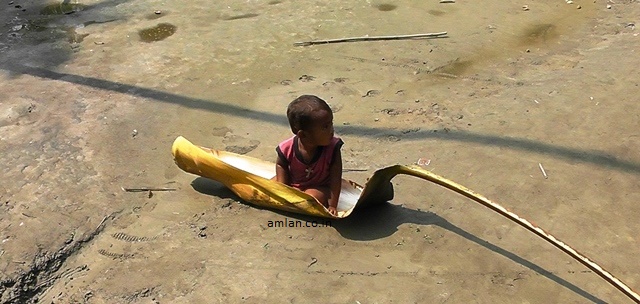Alternative measures of inequality
With my empirical research, I do also work on measurement of economic inequality. I present few such instances as following.
1. A note on the use of decile or quintile group-share of income or consumption from the popular income inequality databases to explain inequality conditions
Abstract: As Gini coefficient does not summarise all that an income distribution can tell us about inequality, there has been an increasing thrust in literature on supplementing or even replacing the use of it by direct examination of the income distributions. However, the problem that remains with the common readers is that they are to rely on popular databases of inequality for Gini coefficient based on microdata; and on income distributions, which are squeezed into deciles or quintiles. The basic question is that whether such grouped data are consistent enough to do the practices as stated above. Any doubtful use of those may be very misleading. In such a situation, we perform some consistency checks of inequality data available in various World Development Indicators and World Income Inequality Database – WIID 3.4 for illustrative purpose only in interest of the common readers. In this connection, we discuss about the issues like shortfall, underestimation, bias etc. As observed from the preliminary results, nearly 7.5 % and 13 % cases appear to be unusual in quintile and decile data respectively in WIID 3.4. Some of these are simply misreporting or typos, which are to be corrected, and some appear to be very special (with positive bias instead of downward bias), which warrant theoretical attention for further research. Common readers may restrain themselves from using the unusual cases in study to explain inequality conditions.
Keywords: Consistency check of inequality data; grouping of microdata; squeezed income distributions; underestimation of Gini coefficient; World Income Inequality Database
Citation: Majumder, A. and T. Kusago. (2018). “A note on the use of decile or quintile group-share of income or consumption from the popular income inequality databases to explain inequality conditions”, Economics Bulletin, 38 (4): 2152-2166.
A copy of the full paper is available here: Majumder-Kusago Inequality Paper Economics Bulletin December 2018.
The original link of the paper in Economics Bulletin is available here.
(Please ignore the two unnecessary pages after the title page in the original file, which might have appeared due to technical error!)
2. Application of Snell’s law in the measurement of economic inequality
Abstract: In this paper, I present a pair of new measures of economic inequality with the application of Snell’s Law. The idea originates when I envisage, with fantasy, that a society without economic inequality is nothing but a state or condition where light touches everyone without refraction. The egalitarian line of the Lorenz Curve Framework, for measuring economic inequality, represents such an ideal condition. In reality, however, it deviates or refracts from the ideal condition, as we live in a stratified society with varying living conditions. Refractive index has origin in geometrical optics, where it measures bending of a ray of light passing from one homogeneous transparent medium into another. As light refracts according to characteristics of different media, so also Lorenz Curve does according to concentration of wealth or income in different strata. Thanks to this analogy, first, I compute refractive (inequality) index for each income group in a distribution to study inequality condition in each, and then simply add all and standardise to propose an overall measure for the whole framework. I utilise data on quintile group shares of income or consumption from the UNU-WIDER World Income Inequality Database – WIID 3.4, 2017 with 180 countries and 5604 cases. Results are noteworthy. While a refractive index value of less than 1.00, in case of light, refers an ‘anomalous refraction’, such a condition of economic inequality is found to be too common for many of us in reality. In contrast to that, in more than 31% of the cases, the index value of the richest group lies above 2.00, where the same of 1.00 depicts an ideal condition that is enviable. With many attractive properties, the summative overall measure appears to be pro transfer-sensitive and ornamental going far beyond the most popular Gini coefficient, which is simply transfer-neutral.
Keywords—Index of refraction, Lorenz curve, measurement of economic inequality, Snell’s Law
The abstract has been published in the American Journal of Computer Science and Information Technology.
Link: The abstract can be accessed here.
The pdf version is available here: 2349-3917-C1-003-010-Amlan Majumder.
3. A new pro transfer-sensitive measure of economic inequality under the Lorenz curve framework in analogue to the index of refraction of geometrical optics.
Abstract: Index of refraction is found to be a good measure of economic inequality within the Lorenz curve framework. It has origin in geometrical optics, where it measures bending of a ray of light passing from one homogeneous transparent medium into another. As light refracts according to characteristics of different media, so also Lorenz curve does according to concentration of wealth or income in different strata. With the sole objective of applying this analogy to the Lorenz curve framework, first, I compute refractive (inequality) index for each stratum in a distribution to study condition in each with respect to the ideal condition, and then simply add all and standardise to propose an overall measure for the whole framework. I utilise data on decile group shares of income or consumption for 149 countries from the UNU-WIDER World Income Inequality Database (WIID3.0b), September 2014. Results are lively and remarkable. While a refractive index value of less than 1.00, in case of light, refers an ‘anomalous refraction’, such a condition of economic inequality is found too common for many of us (50-80 %) in reality. In contrast to that, in most of the countries, the index value of the richest group lies in between the proximities of 2.00 and 5.00, where the same of 1.00 depicts an ideal condition that is enviable. The summative overall measure appears to be pro transfer-sensitive and equivalent to those based on the length of the Lorenz curve and consequently goes beyond the Gini coefficient, which is simply transfer-neutral.
Keywords: Anomalous inequality, Geometrical optics, Gini coefficient, Refractive inequality index, Refractive Lorenz index
JEL classification: D310, D630, O150.
Availability (at the Econophysics Forum): (1) https://www3.unifr.ch/econophysics/?q=paper/download/27607/pdf
Or (2) http://www.iariw.org/dresden/amlanmajumder.pdf.
Citation: Majumder, A. 2016. “A new pro transfer-sensitive measure of economic inequality under the Lorenz curve framework in analogue to the index of refraction of geometrical optics”, Paper accepted for presentation at the 34th IARIW (International Association for Research in Income and Wealth) General Conference in Dresden, Germany, 21-27 August 2016.
Amlan’s Submission Stat at Econophysics Forum: (https://www3.unifr.ch/econophysics/?q=user-history/amlan)



4. An alternative measure of economic inequality under the Lorenz curve framework in analogue to the index of refraction of geometrical optics.
Abstract: Index of refraction is found to be a good measure of economic inequality within the Lorenz curve framework. It has origin in geometrical optics, where it measures bending of a ray of light passing from one transparent medium into another. As light refracts according to characteristics of different media, so also Lorenz curve does according to concentration of wealth or income in different strata. In line with this analogy, first I compute refractive index for each stratum under the Lorenz curve framework to evaluate condition in each and then simply add all to propose an overall measure for the whole framework. The latter appears to be pro transfer-sensitive and equivalent to the measures based on length of the Lorenz curve. Also, it is related to transfer-neutral Gini coefficient by quadratic equation. The applicability of the approach is tested utilising data on distribution of income or consumption from the WDI 2014. Results are lively and remarkable. While an index value of less than 1.00 represents an ‘anomalous refraction’ in optics, such a condition of inequality appears to be too common for many of us in reality. In contrast to that, in some countries, the refractive index of the richest group exceeds that of Diamond (2.42), where an index value of 1.00 depicts an ideal condition that is enviable. Although the preliminary exercise is done with grouped data, it can be extended vividly to the case when the Lorenz curve is continuous.
Availability: (1) http://www.accessecon.com/Pubs/EB/2015/Volume35/EB-15-V35-I2-P110.pdf.
Or (2) https://www3.unifr.ch/econophysics/?q=paper/download/27603/pdf.
Citation: Majumder, A. 2015. ”An alternative measure of economic inequality under the Lorenz curve framework in analogue to the index of refraction of geometrical optics”, Economics Bulletin, 35 (2): 1076-1086. (ISSN: 1545-2921)

5. An alternative measure of economic inequality in the light of optics.
Abstract: An ideal state of development, when viewed with fantasy, is nothing but a state or condition where light touches everybody without refraction. The diagonal line of the Lorenz Curve Framework represents such an ideal condition. In the presence of inequality, however, it deviates or refracts from the ideal condition. In this paper, I try to measure economic inequality from the index of refraction. First, I compute such an index for each stratum to evaluate condition in each and then add all to propose an overall measure of economic inequality, which appears to be a standardised measure of the length of the Lorenz Curve relative to that of the diagonal line. The exercise is done utilising data on distribution of income or consumption from the WDI 2014. Results are lively and remarkable. While an index value of less than 1.00 represents an ‘anomalous refraction’ in Optics, such a condition of inequality is true and too common for many of us (60-80 %) in reality. In contrast to that, in some countries, the index of refraction of the richest group exceeds that of Diamond (2.42), where an index value of 1.00 depicts an ideal condition that is enviable. In regard to technicalities, it goes at par Gini Index and beyond. Additionally, it makes analysis of economic inequality more sensible. Presumably, the proposed index could be a good substitute of the Gini Index as it is found perfectly correlated with the latter by quadratic equation with an Adjusted R Square value of 1.00.
Availability: (1) http://www.ecineq.org/milano/WP/ECINEQ2014-346.pdf.
Or (2) https://www3.unifr.ch/econophysics/?q=paper/download/27604/pdf.
Citation: Majumder, A. (2014). “An alternative measure of economic inequality in the light of optics”, ECINEQ Working Paper 2014-346: Verona. Available at: http://www.ecineq.org/milano/WP/ECINEQ2014-346.pdf.
[Please see my blog posting of 30 December 2014 for updates in regard to ECINEQ 2014-346]

6. A discreet approach to study the distribution-free downward biases of Gini coefficient and the methods of correction in cases of small observations.
Abstract: It is well-known that Gini coefficient is influenced by granularity of measurements. When there are few observations only or when they get reduced due to grouping, standard measures exhibit a non-negligible downward bias. At times, bias may be positive when there is an apparent reduction in sample size. Although authors agreed on distribution-free and distribution-specific parts of it, there is no consensus in regard to types of bias, their magnitude and the methods of correction in the former. This paper deals with the distribution-free downward biases only, which arise in two forms. One is related to scale and occurs in all the cases stated above, when number of observations is small. Both occur together if initial number of observations is not sufficiently large and further they get reduced due to grouping. Underestimations associated with the former is demonstrated and addressed, for discontinuous case, through alternative formulation with simplicity following the principle of mean difference without repetition. Equivalences of it are also derived under the geometric and covariance approaches. However, when it arises with the other, a straightforward claim of it in its full magnitude may be unwarranted and quite paradoxical. Some exercises are done consequently to make Gini coefficient standardised and comparable for a fixed number of observations. Corrections in case of the latter are done accordingly with a newly proposed operational pursuit synchronising the relevant previous and present concerns. The paper concludes after addressing some definitional issues in regard to convention and adjustments in cases of small observations.
Availability: http://www.ecineq.org/milano/WP/ECINEQ2013-298.pdf.
Citation: Majumder, A. and T. Kusago. 2013. “A discreet approach to study the distribution-free downward biases of Gini coefficient and the methods of correction in cases of small observations”, Working Paper Series, ECINEQ 2013-298, http://www.ecineq.org/milano/WP/ECINEQ2013-298.pdf.

7. Alternative measures of economic inequality.
Abstract/Introduction: If we consider a particular distribution of income or consumption with n-number of groups / individuals, for same amount of transfer of resources between any two groups, Gini coefficient shows equal sensitivity provided transfer of income occurs between two successive groups / individuals. Such a judgment contradicts with the sensitivity level of our mind. We will not pay equal attention to a tiny transfer of resources between two persons in the worst off groups in a society and to a similar transfer between two persons in the best off groups in that society. Similarly, its sensitivity is constant for same amount of transfer from the worst off person to the best off person in the society and to the same in the reverse direction. Moreover, we can observe that Gini coefficient expresses more concern for countries, which are closer to the line of absolute equality. For example, according to the World Development Indicators 1999, Slovak Republic has more equal and Brazil has highly unequal distributions of income or consumption. According to that report, Gini coefficients for the two countries are 19.5 and 62.9 respectively. However, it can be checked that for a tiny transfer of resources from one group to another, the changes in the Gini coefficient would be much higher in Slovak Republic than in Brazil. In order to address some of the above-mentioned issues, few other indices like variance, coefficient of variation and standard deviation of logarithms have also been brought into track, but those have been found incompetent either because of their total concentration on differences around mean or because of violating Pigou-Dalton condition. Pigou-Dalton condition implies that any transfer from a poorer person to a richer person, other things remaining the same, would always increase the inequality measure. In line with the same one may also think of decrease in inequality measure in response to transfers from the rich to the poor. In such a situation it is necessary to develop some measures or modify the existing ones to address the above-mentioned issues. The present paper does similar exercise and develops some measures within the Lorenz curve framework or modifies the existing ones using available data set for 96 countries on distribution of income or consumption from World Development Indicators 1999.
Availability: A copy of the paper is available here: Amlan Paper Economic Inequality-Download Link.
Citation: Majumder, A. 2007. “Alternative measures of economic inequality,” Artha Beekshan (Journal of Bengal Economic Association), 16 (1): 3-20. (ISSN: 0972-1185)

The beginning …
When I started research on measurement of inequality, I have one book only with me … that of Sen and Foster. I did not pay adequate attention too in this particular topic, as I was involved in my doctoral work on economics of health care utilisation, and other works on capability and well-being, etc. However, I wrote something and sent the abstract of it to the First Meeting of the Society for the Studies in Economic Inequality (www.ecineq.org) in 2005. The abstract was accepted (www.uib.es/congres/ecopub/ecineq/papers/169majmuder2.doc) and I was motivated enough to work further on the issue. I realised that I am not familiar with relevant literature in this field. As I live and work in a remote place with very limited access to literature, it was not possible for me to be updated on the issue. I made a personal request to Prof. Branko Milanovic (The World Bank) to send some of his papers. I am grateful to him, as he responded to my request. In 2006, I have submitted the paper to the Journal of Bengal Economic Association (Artha Beekshan). I am highly indebted to the anonymous referee of the Journal for her/his six-page review and comments on my paper. The referee advised me to incorporate works of Prof. Sudhir Anand (Oxford University) on this issue. However, it was not easy, as the book was out of print. I made a personal request to Prof. Anand for that particular work/paper. However, he replied me that the paper was available with Prof. S. Subramanian (Madras Institute of Development Studies). Then I made a request to Prof. Subramanian for the paper and he sent me a copy of the same by speed post. Finally, I have completed my paper, which was published in 2007. I convey my gratitude to all.

8. A note on Gini index of Liberia in World Development Indicators 2009
Either the Gini index or the distribution of income or consumption of Liberia is inappropriate in the World Development Indicators (WDI) 2009. In the present exercise, we have computed Gini coefficients for 135 countries to show that Liberia deviates widely from the usual pattern. We have then estimated the relationship between the computed Gini coefficients of 134 countries (except Liberia) and those of the WDI 2009 using OLS method to predict the appropriate value of Liberia as it should be in the WDI 2009. The Gini index of Liberia should be 37.9 instead of 52.6. However, if the distribution is inappropriate, it needs exact replacement or we have to follow our intuition to replace it by a suitable pattern as in case of Lesotho or Nicaragua or Chile etc. The Bank may include such an exercise in the curricula while computing Gini index as a precautionary measure.
A copy of the paper is available here: A note on Gini index of Liberia in WDI 2009-Download Link.
The note has been cited in the following paper:
Kamdem Jules Sadefo (2012). A nice estimation of Gini index and power Pen’s parade. Economic Modelling, 29: 1299–1304.
However, please be informed that my surname is misspelled there [Please read “Majumder” instead of “Majumber”].

9. My paper at ECINEQ 2013, Bari, Italy
I am pleased to share that my paper on inequality: “An appraisal to alternative Gini Coefficient formulation for the issue of underestimation in cases of small observations” is accepted for presentation at the ‘Fifth meeting of the Society for the Study of Economic Inequality (ECINEQ)’, Bari (Italy), July 22-24, 2013. This theoretical research has been in commemoration of 100 years of Gini’s mean difference: 1912-2012.
Abstract: It is commonly felt that Gini coefficient is influenced by granularity of measurements. For example, five quintiles (low granularity) usually yield a lower Gini coefficient than twenty ventiles (high granularity) taken from the same distribution. This phenomenon is usually perceived as an often encountered problem with computation of Gini coefficients. Factually, when there are few observations only or when they get reduced due to grouping, all the standard measures exhibit a non-negligible downward bias. However, there is no consensus on the issue in regard to types of bias, their magnitude and the methods of correction. This paper identifies three types of bias, two of which are non-stochastic and they may arise together. Underestimations associated with these two are considered and addressed with simplicity synchronising relevant previous and present concerns.
Structurally, the paper: (i) simplifies the standard measure under the Gini’s mean difference approach in regard to use of simple spread sheet programmes, (ii) highlights the source of Type I bias under the Gini’s mean difference approach, geometric approach and the covariance approach and propose alternative formulations accordingly, and (iii) discusses about Type II bias and its possible solution. The paper is concluded addressing some definitional issues in regard to convention and adjustments in cases of small observations.

Consistency of inequality data in WDI
Recently I have performed a consistency check of data on inequality available in WDI 2008-2012. The objectives of such an exercise are twofold: first, to understand the extent to which the squeezed distribution of income or consumption conforms to the reported Gini based on micro data; and second, to study the types of bias that may arise due to grouping, their magnitude and the methods of correction. The first attempt (by this author) was made in July 2010 with table 2.9 of WDI 2009. Ginis were computed using fractile (quintile) data following a standard measure and then compared the calculated Ginis with the ones reported in WDI. For a country, the difference between the two should be relatively small because the fractile data and the Gini must be consistent, and the error is basically the one that arises due to grouping (since we have just a few fractiles in WDI, and the Ginis are calculated from micro data). The derived results show exactly this to hold for all the countries with the exception of Liberia. The difference between the computed and reported values for Liberia has been 17.64 Gini points, which is quite absurd. As a straightforward measure, although crude, OLS method was applied to predict the appropriate Gini index, which came to be 37.94. The Bank was communicated accordingly and an erratum was published in April 2011 showing the original index value, 38.2. The OLS method of regression shows a 0.26 Gini-point underestimation.
It is desirable to do a consistency check of data, correcting the Ginis based on squeezed distributions for possible biases or errors. Although there is no consensus in literature in regard to types of bias, this study recognises three types of bias, two of which are certain (non-stochastic) when number of observations get reduced due to grouping. The remaining type of bias is distribution-specific. If the number of observations in micro data is known, extents of all types of bias can be measured directly or indirectly with an ease, and the said check may be performed. This study, therefore, highlights the need for displaying number of observations in micro data in the table for Gini index in WDI.
In line with the above, after doing a systematic exercise, it has been observed that the magnitude of all types of biases may be as extensive as 5 Gini points (if n ≥ 5000 in micro data). So, if we roughly assume 5 Gini points as a cut-off mark for bias, and do a consistency check (as mentioned in the first paragraph), a number of African (and Latin American) countries draw our attention. Further, as standard literature suggests a downward bias only due to grouping, the cases of positive bias for Togo in 2010 and 2011 (with Denmark and Sweden in various years; the cases of Micronesia and Seychelles in 2010 are simply wrong entries) need further attention. As the WDI is a unique source of data on inequality, such an exercise will bring more transparency in its presentations.
For more information please contact me or write me to: amlan@amlan.co.in.

Making it simple!
Keeping the original spirit and essence unchanged, economists in field of measurement of inequality have always been in the quest of presenting simpler ways to calculate Gini coefficient. Among such efforts, the work of Pyatt, Chen, and Fei (1980), which has been used more recently by Lerman and Yitzhaki (1984), Yitzhaki (1994), and the works of Milanovic (1994, 1997) draw our attention. Among these, the first two have been operationalised mainly by taking into account covariance between income and ranks of all individuals. Milanovic (1994) has worked out a geometric formula with the intention of proposing an alternative and intuitively simpler derivation of the Gini coefficient. In his latter effort (see Milanovic 1997), he modifies the work of Pyatt, Chen, and Fei (1980) and claims that since all the components of the formula are easy to calculate, the Gini can be obtained using a simple hand calculator. Having similar objectives, I tried to make the calculation of Gini-coefficient even more simpler!

For more information please write me to: amlan@amlan.co.in.